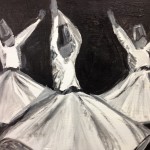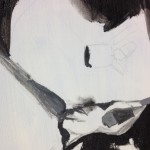Dancing with Dervishes
The story goes that Jalal ad-Din Rumi was walking through the Market one day, and heard the rhythmic hammering of the goldbeaters as they went about their work. In this beat he heard a dikhr, and overcome by ecstasy, he starting spinning in circles.[1]
And so the whirling dervishes were born…
Whether or not this is the exact origin of the Mevlevi Sufi order in the 13th century, it does pays tribute to the importance of the “Sama” practice in Sufi traditions. Directly translated, “Sama” means “audition” and Sufis interpret it as hearing with the “ear of the heart.”[2] Persian scholar, Leonard Lewisohn, describes it as “an attitude of listening to music with the intent of increasing awareness and understanding of the divine object described.”[3] Sama happens at events with music, poetry and dancing, and it is at these services where the whirling dervishes spin.
I was inspired to paint a piece on the dervishes, because I feel that they are representative of the many ways and forms that people can use to worship God. This act of spinning is a way for them to connect with the divine and reach a state of ecstasy (wajd).[4] It is a true expression of religion as being an experience. Prayer does not need to be confined to words, thoughts or scriptures. In the dance there are many elements of symbolism, and I decided to paint my picture in black and white to show this. The black represents the black cloak that the dervishes start out wearing, and the white is the white skirts they reveal underneath, symbolizing spiritual rebirth.[5] They are simple colors, because I wanted the focus to be on the movement of the figures in the painting. My use of negative and positive space, distinctly identifiable by the opposing colors, is blurred through the grey edges of their skirts, drawing attention to their movement. The figures faces are unidentifiable, as I wanted to show that they have dropped their ego and individuality as they reach oneness with God.
There has been a lot of controversy over the role of music and dancing in Islam, and the dervishes have come under criticism for their practices. However they make the strong argument that it is not the spiritual form, but the purity of intention and the sensitivity of the listener that should be the cause for concern.[6] Like one early Sufi said “”Sama” is forbidden for the masses, so that they may preserve their souls; it is permitted for ascetics, so they may attain the goal of their efforts; and it is recommended for our companions [the Sufis], so that they may enliven their hearts.”[7] I can’t think of a more beautiful expression of love than this connection with the divine, and hope they keep spinning for centuries to come.
[1] Ali Asani, Culture and Belief 12 Lecture, Week 8 Spring 2012.
[2] Lewisohn, The sacred music of Islam in the British Journal of Ethnomusicology, vol.6 (1997), 4.
[3] Lewisohn, The sacred music of Islam, 4.
[4] Carl W Ernst, The Shambhala Guide to Sufism, 182
[5] Ali Asani, Culture and Belief 12 Lecture, Week 8 Spring 2012.
[6] Carl W Ernst, The Shambhala Guide to Sufism, 181










